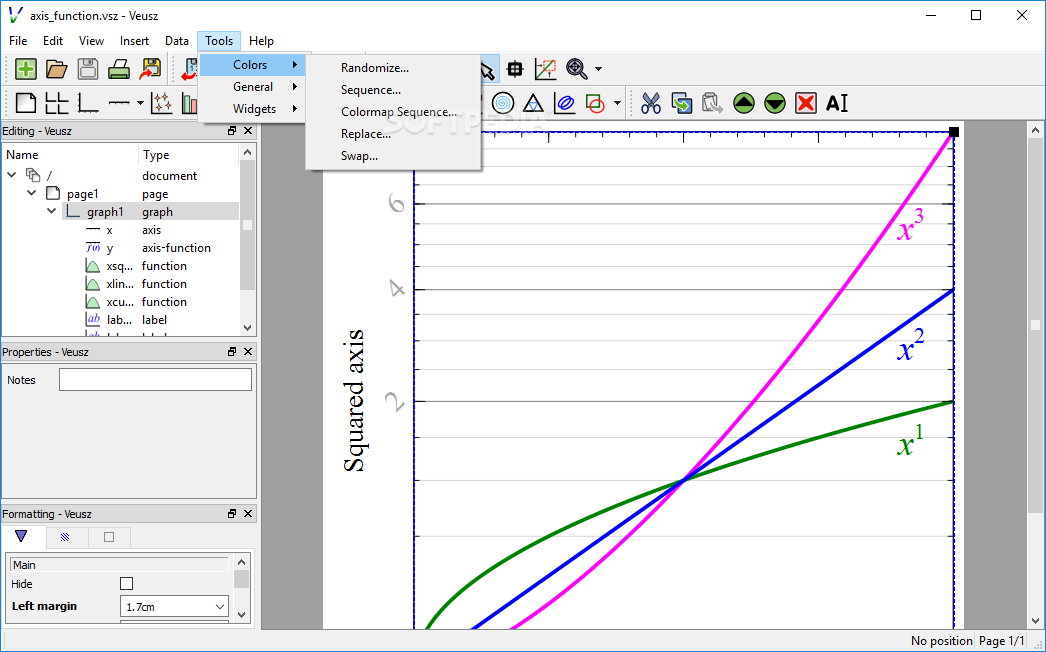

ALTERNATIVES TO VEUSZ WINDOWS
Also, you're forced to stick to Windows with Sigmaplot. Sigmaplot (v12.5) is also pretty easy to use, although it misses some basic features like rearranging the order of legend items, and sometimes it gets overly complicated (like in running furmulas on data, for example). It behaves more like some sort of web applet which is not supposed to be printed. LibreOffice Calc should be able to do pie. I mean there could be workarounds such as calculating the fractions manually and plotting them in polar coordinates, but to be honest I dont think its worth it. SciDAVis on the other hand keeps rescaling and adjusting graphs to the size of their windows and it's not clear what you'll get once printed. I didnt found any pie chart related examples on the Veusz example page, therefore I think that is not a function of veusz. Sigmaplot is more print-oriented, it makes a better use of the space in the page, and it always show the plot as it would appear on paper, kind of like a picture in a word processor. Its dowsides are that it has just one style of dashed line and that setting up a plot for printing is quite a mess. SciDAVis felt more like a well thought out software, I especially liked the Data reader tool, and the fact that I didn't need to read through 10 pages of documentation to make an acceptable graph. So having used both for the same (narrow) task, I'll make a brief comparison. When I was left with only my Linux machine and a bunch of JNB (Sigmaplot) files completely inaccessible, I re-made the plots with SciDAVis. It's better than Sigmaplot, which my supervising professor uses, and so I have to, too. Following the step by step interactive tutorial will get you ready to create even the most complex representations, and give them a unique design pattern using the various customization options.I haven't used it extensively, but I've found it to be quite intuitive and well featured.
ALTERNATIVES TO VEUSZ PROFESSIONAL
Taking everything into consideration, we can say that Veusz offers a professional approach on graph building. In addition, you can choose to fill areas that are, for example, below or above your line of interest.Īfter you are happy with the graph configuration you can choose to print it out on a sheet of paper, save it as a project for later editing, or export it as some of the most common image file types, in case you need to use it in other applications. The displayed bars and points can be modified to have any color and shape that suits your needs. For the most accurate result, functions are used to define what the end result will look like. Graphs are built-up by combining plotting widgets. SciDAVis felt more like a well thought out software, I especially liked the Data reader tool, and the fact that I didn't need to read through 10 pages of documentation to make an acceptable graph. It can also be used as a module in Python for plotting. They are all stored in the “Editing” window to easily be accessed anytime. Veusz (pronounced Views) is a scientific plotting and graphing program with a graphical user interface, designed to produce publication-ready 2D and 3D plots in EPS, PDF, SVG and bitmap formats. Each has its own style of representing the info you input. Create and customize graphsĪ set of widgets is put at your disposal to design your graph. This proves to be helpful seeing how you are given plenty of tools to work with. You will be taken step by step through some of the basics, after which you can start making use of its various functions. If you are new to these kind of utilities you'd best take advantage of the help it has to offer. Interactive tutorial to guide you through

Veusz is one of them, and gives you the possibility to create endless types of graphs out of your data. Nothing can offer more accurate results than a computer application.


 0 kommentar(er)
0 kommentar(er)
